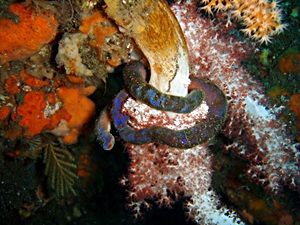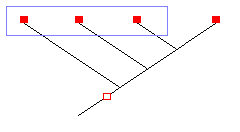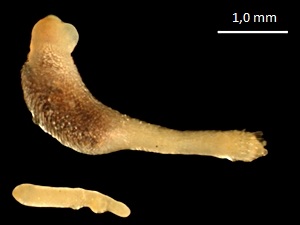Shell-less Molluscs ("Aplacophora")
| Class |
Species No. |
| Snails (Gastropoda) |
43.000 |
| Mussels (Bivalvia) |
10.000 |
| Squids (Cephalopoda) |
650 |
| Elephant Tusks (Scaphopoda) |
600 |
| Neopilina (Tryblidia) |
20 |
| Chitons (Placophora) |
750 |
| Solenogastres |
230 |
| Caudofoveata |
120 |
|
|
| Molluscs (Mollusca) |
55.400 |
Species number of molluscs.
 Diagram.
Diagram. |
|
|
Among the shell-less molluscs ("Aplacophora") there are about 340 of
the most primordial molluscs to be found on earth. As their scientific name
Aplacophora literally states, the members of this group actually are devoid of a
shell and in that regard are unique among molluscs. Instead of a shell, their
exterior is protected by a sturdy skin, the cuticula, reinforced with calcareous
spines or scales, which give the creature a glossy sheen.
Two classes are grouped among the aplacophoran Molluscs:
Caudofoveata and
Solenogastres. All aplacophoran molluscs
exclusively live in the sea, caudofoveatans living on the ocean floor feeding on
micro-organisms and detritus, solenogasters living and feeding on corals and
other cnidarians.
| |

Many solenogasters (Epimenia babai) live and feed on corals.
Source:
Atwiki.jp. |
Shell-less molluscs are opposed to all other molluscs which are combined as
shell-bearing molluscs (Testaria). Apart from molluscs with complete shells,
such as snails, clams and cuttlefish, there are also the
chitons (Polyplacophora).
Those do not have a complete shell,
but their back is protected by eight shell plates.
 The mollusc system. Source: Nordsieck, R.
(2008), see bottom of page.
The mollusc system. Source: Nordsieck, R.
(2008), see bottom of page.
All other mollusc classes possess a real one-part shell and therefore are
combined as Conchifera, shell-bearing molluscs. Among those there are the
snails and slugs (Gastropoda),
mussels and clams (Bivalvia),
scaphopods (Scaphopoda) and
squids, octopuses and
cuttlefish (Cephalopoda). The bivalve shell only divided itself into
two halves but later in evolution. Also a class of conchiferan molluscs is the
class of Neopilina and its relatives (Tryblidia
or "Monoplacophora"). Neopilina is a living fossil, one of the
last species of its kind, which is assumed to stand near the most primordial of
conchiferan molluscs, though in the Tryblidia class as well there are
many derived characters.
In further theories towards a systematics of molluscs it has been examined,
if there should be a combined group of spiny molluscs ("Aculifera"), made
from shell-less molluscs ("Aplacophora") and chitons (Polyplacophora)
(neither of both has a complete one-part shell and retains the sturdy cuticula),
as opposed to the "real" conchiferan molluscs.

Paraphyletic group. |
|
It is assumed, though, that the
group of Aculifera would be as paraphyletic as the Aplacophora.
That means that in Aculifera, as well as in Aplacophora, there are
not all descendants of a common ancestor. As phylogenetic analysis attempts to
assemble complete groups of descendants to one preferably specified common
ancestor, paraphyletic groups usually are not accepted, as opposed to
monophyletic groups which do contain all descendants of such an ancestor.
It has proven very difficult to put the shell-less molluscs in order, as
there naturally are very little fossil remnants to work with. All other mollusc
groups have been proven since the Cambrian period more than 540 Mio. years ago,
so the assumption appears to be allowed that the shell-less molluscs were most
likely present at that time as well.
 Geological timeline.
Geological timeline.
| |

Spathoderma californicum, a caudofoveatan. Source:
MBARI. |
Remark:
Finally it shall be remarked that of course not all molluscs without a shell
automatically are placed among the shell-less molluscs! In numerous groups (especially gastropods and cephalopods) there have been
several occasions during evolution, when the shell was reduced for the sake of
higher mobility. But on one side, the shell can be seen in the embryonic stage,
on the other those groups’ basic construction places them into their class
anyway, with or without shell.
Additional Information:
Literature:
Salvini-Plawen, L.; Mizzaro-Wimmer, M.: "Praktische Malakologie - Beiträge zur vergleichend anatomischen
Bearbeitung der Mollusken", Vienna 2001.


